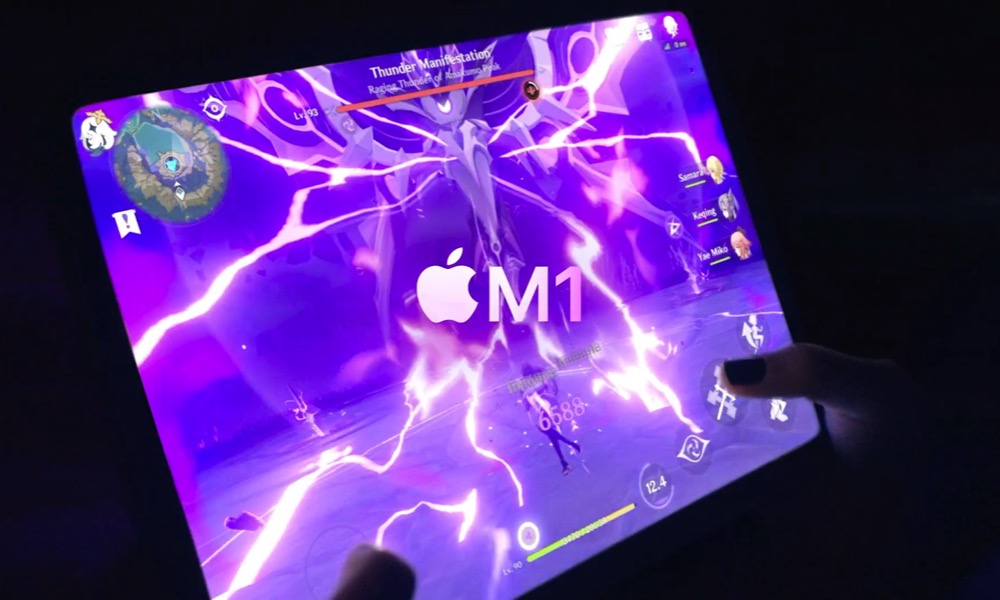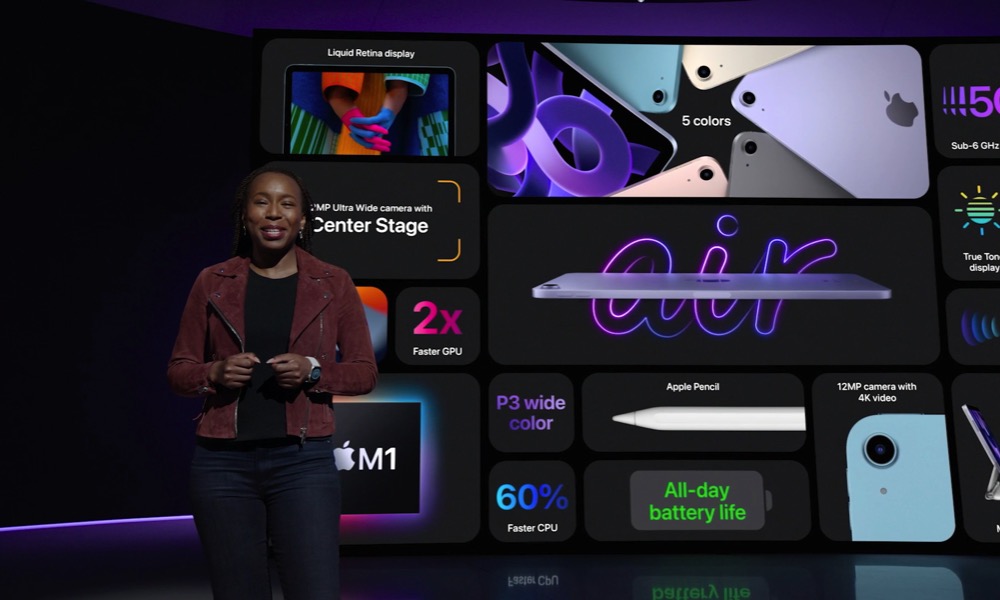Benchmarks Show the iPad Air 5 Is an M1 Powerhouse
 Credit: Apple
Credit: AppleToggle Dark Mode
Last week, Apple surprised us with the release of a new fifth-generation iPad Air with the M1 chip at its core, and it looks like Apple hasn’t cut any corners on delivering “peek performance” to its latest mid-tier iPad.
While the title of Apple’s recent event was likely more about the insanely powerful new Mac Studio, it could just as easily also be referring to the iPad Air 5. After all, we knew a new iPad Air was coming, as it was 18 months overdue for a refresh, but nobody expected Apple to put an M1 chip into it — at least not until an eleventh-hour rumour showed up.
The consensus was that the iPad Air 5 would go to the A15 chip, matching up with the iPad mini 6 that was unveiled this past fall. Apple rebooted the iPad Air and iPad mini as a new midrange class of iPads in 2019, and at the time they were identical in just about every way except for size.
In 2020, the iPad Air 4 came along with a new design, plus the same A14 chip that Apple debuted in its iPhone 12 lineup. In fact, thanks to the global health pandemic, the A14 was announced for the iPad Air nearly a month before the new iPhone models took the stage. At the time, many folks believed the pandemic and the complications it unleashed on Apple’s supply chain were the reasons we didn’t see a new iPad mini at the same event.
So, when Apple unveiled the iPad mini 6 last fall with an A15 chip, it seemed like the two models were just playing leapfrog, and eventually the next generation of iPad Air would catch up. Or, maybe the game would continue, with both iPads featuring even- and odd-numbers A-series chips.
Except that’s not what happened. Instead, the iPad Air 5 went straight to the M1 chip used in Apple’s entry-level Macs and the 2021 iPad Pro.

It was enough of a shock last year when the iPad Pro got the M1 chip. When the dust settled, however, that seemed easy to explain. It was Apple’s highest-end “Pro” tablet, after all, and after the A12Z in the 2020 iPad Pro, it was overdue for something much more powerful. Why make a new “A14X” when you can simply drop in the M1?
Presumably, this is the same logic Apple has applied to the iPad Air 5. It already has the M1, so it saves the company the trouble of building a whole new chip. Besides, the M2 chip is almost certainly right around the corner, so the standard M1 chip is yesterday’s news by now.
Apple’s ‘Generation X’ Is Over
It’s also fair to say a lot has changed since the days of Apple’s “X” chips. For years, Apple’s higher-end iPads generally got souped-up versions of its iPhone chips. This began in 2012, when the short-lived third-generation iPad came out with an A5X chip, which needed two additional GPU cores to power its new Retina Display, as compared to the A5 found in the iPad Air 2 and iPhone 4S.
This continued with the A6X, which came along only six months later in the fourth-generation iPad. In 2014, the A8X showed up in the iPad Air 2 as the first 64-bit X-series chip, also marking the first 8-core GPU in an Apple-made chip.
This was followed by the A9X in the original iPad Pro, the A10X Fusion in the next-generation iPad Pro lineup (and the 2017 Apple TV 4K), the A12X Bionic in the 2018 iPad Pro, and the rather odd A12Z in the 2020 iPad Pro.
In retrospect, it’s probably easy to see why we didn’t get an “A13X” in 2020. Apple’s chip design and engineering team clearly had its hands full with the M1, which debuted only a few months later in the MacBook Air, 13-inch MacBook Pro, and Mac mini. However, this also explains why there will likely never be another “AX” series Apple chip.
All those chips came out when Apple was relying on Intel for its Macs. The standard A-series iPhone chips weren’t powerful enough to handle the needs of the iPad — the higher-resolution Retina Display was the entire reason the original A5X was created in the first place. Apple had no choice but to design something better.
Once the Macs moved to Apple Silicon, however, Apple already had something better — the M1. If that chip could power a 24-inch iMac, it could certainly handle a 12.9-inch iPad Pro. I think we can all agree that Apple’s resources are better spent building bigger and better A-series and M-series chips than attempting to cobble together something just to distinguish the iPad from a Mac.
The M1 iPad Air: No Compromises
What’s interesting, though, is that Apple clearly intends that an M1 chip be an M1 chip, regardless of what device it’s placed in.
Last year, some wondered if perhaps the iPad Pro had a more limited M1 chip, but the benchmarks quickly proved that wasn’t the case. In fact, Apple didn’t even go with the “binned” 7-core GPU chips used in the cheapest MacBook Air — the iPad Pro got the full M1 treatment.
Not surprisingly, many have now been asking the same questions about the M1 iPad Air. How could Apple possibly intend for a $599 iPad Air to deliver the same performance as a $799 iPad Pro?
Well, the M1 iPad Air does deliver the same performance as just about every M1 Mac and the iPad Pro — and it’s clearly exactly what Apple intends.

Apple could have deliberately down-clocked the M1 chip, or even used the 7-core “binned” versions, but it didn’t. Like the iPad Pro, the new iPad Air is getting the full 8-core GPU M1 chip, which puts it slightly ahead of even the $999 MacBook Air.
According to the latest Geekbench 5 results, the new M1 iPad Air offers performance that’s basically identical to the M1 iPad Pro.
This is even more surprising when you consider that Apple did down-clock the A15 chip in the iPad mini 6, which runs at 2.9GHz rather than the 3.2GHz of its iPhone 13 counterparts. The A15 in the iPad mini 6 has the same 5-core GPU as the version used in the iPhone 13 Pro, but it still comes in around 5 percent slower than even the standard iPhone 13 in most benchmark tests.
Of course, the iPad Pro still has a lot more going for it, like Face ID, a 120Hz ProMotion Display, and a better sound system — and that’s obviously how Apple intends to set it apart. The iPad Pro will likely soon be updated with an M2 chip as well. In short, there are still many good reasons to opt for an iPad Pro, but for now at least, performance isn’t one of them.








